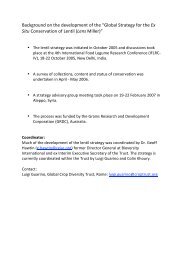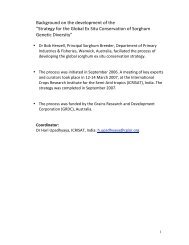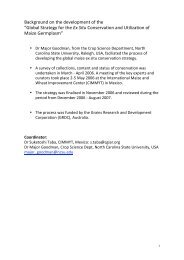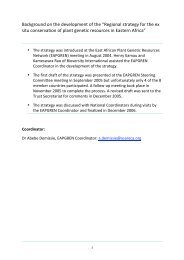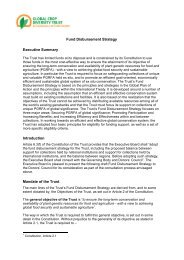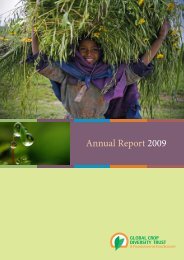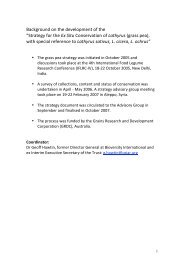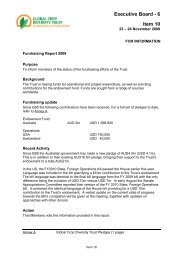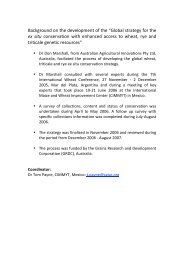Global Strategy for the Ex Situ Conservation of Potato - Global Crop ...
Global Strategy for the Ex Situ Conservation of Potato - Global Crop ...
Global Strategy for the Ex Situ Conservation of Potato - Global Crop ...
You also want an ePaper? Increase the reach of your titles
YUMPU automatically turns print PDFs into web optimized ePapers that Google loves.
was only partly completed. In general, passport data are more completely computerised than<br />
data on characterisation, evaluation and internal genebank management. The international<br />
potato databases <strong>of</strong> APIC and ECP/GR, containing passport data, are far from complete, and<br />
are lacking in particular data <strong>of</strong> collections in Latin America and Asia. Characterisation and<br />
evaluation data are not included in <strong>the</strong> international databases at all, and only few<br />
genebanks provide this type <strong>of</strong> in<strong>for</strong>mation through <strong>the</strong>ir own websites. Improvement <strong>of</strong> <strong>the</strong>se<br />
databases will substantially contribute to a better management, conservation and utilization<br />
<strong>of</strong> potato germplasm.<br />
Storage. Facilities <strong>for</strong> ex situ conservation and storage are generally adequate <strong>for</strong> those<br />
collections maintaining botanical seeds. Only some banks in Latin America need to upgrade<br />
this type <strong>of</strong> facilities. The storage conditions <strong>of</strong> tubers vary enormously, particularly <strong>for</strong><br />
temperatures and relative humidity in <strong>the</strong> cold stores. There<strong>for</strong>e standardisation is highly<br />
recommended. Several genebanks (Latin America and Russia) report not to have optimal<br />
facilities <strong>for</strong> storage <strong>of</strong> vegetative material; <strong>the</strong>ir facilities need to be upgraded.<br />
Health status. Seed-borne diseases in true seeds and virus infections <strong>of</strong> tubers seriously<br />
restrict distribution <strong>of</strong> potato germplasm. Seventeen genebanks report to have problems in<br />
securing a sufficient health status <strong>of</strong> <strong>the</strong>ir germplasm. The eradication <strong>of</strong> viruses from tubers<br />
<strong>of</strong> cultivated potato material is a remittent need, since cleaned germplasm <strong>of</strong>ten gets infected<br />
again after a certain period. Several genebanks in Latin America and Russia do not have<br />
(access to) sufficient experience or facilities to keep <strong>the</strong> potato germplasm healthy.<br />
Safety duplication. Eighteen curators indicated that <strong>the</strong>ir collection has been partially or<br />
completely safety duplicated elsewhere. It is not clear in sufficient detail how many<br />
accessions <strong>of</strong> potato are currently safety duplicated. It is recommended to investigate and<br />
update – if needed - <strong>the</strong> level <strong>of</strong> safety duplication once <strong>the</strong> databases have been improved.<br />
Networks in potato genetic resources<br />
Few networks and partnerships exist, one international network (APIC), a regional network<br />
(ECP/GR), and a set <strong>of</strong> institutional partnerships coordinated by CIP. The networks are not<br />
heavily <strong>for</strong>malised and meet <strong>of</strong>ten on an ad hoc basis. Participants at <strong>the</strong> Lima workshop<br />
expressed <strong>the</strong>ir interest to extend and broaden <strong>the</strong> networks in a new setting following <strong>the</strong><br />
outline <strong>of</strong> APIC, but with more partners.<br />
Utilisation <strong>of</strong> collections<br />
The substantial amount <strong>of</strong> potato germplasm distributed to users indicates that germplasm is<br />
extensively used. There are, however, large differences in distribution between genebanks,<br />
ranging from a distribution from 23 to 7,630 accessions per year. Un<strong>for</strong>tunately, it appears<br />
not to be common practice <strong>for</strong> users to return in<strong>for</strong>mation <strong>of</strong> <strong>the</strong> evaluation <strong>of</strong> <strong>the</strong> requested<br />
germplasm to <strong>the</strong> providing genebank.<br />
Priority selection<br />
The Lima workshop discussed <strong>the</strong> existing networks in potato germplasm, <strong>the</strong> constraints in<br />
important genebank functions and <strong>the</strong> possibilities <strong>for</strong> future cooperation. During <strong>the</strong><br />
workshop a Consortium <strong>for</strong> global conservation <strong>of</strong> potato genetic resources was established<br />
in which representatives <strong>of</strong> all 13 genebanks present in Lima will participate. An advisory<br />
group <strong>of</strong> <strong>the</strong> Consortium was established that may also support <strong>the</strong> Trust at its request .<br />
In establishing priorities <strong>for</strong> a rational system qualifying <strong>for</strong> support by <strong>the</strong> Trust, it was<br />
assumed that assistance may be provided in <strong>the</strong> <strong>for</strong>m <strong>of</strong> ei<strong>the</strong>r support to collaborative<br />
projects <strong>of</strong> several genebanks, or alternatively, support <strong>for</strong> capacity building and upgrading <strong>of</strong><br />
individual genebanks to correct apparent constraints regarding facilities and training.<br />
6




